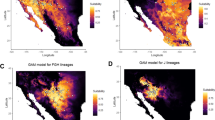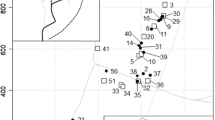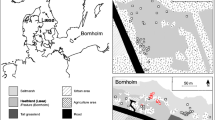Abstract
Combined genetic and morphological data indicate frequent hybridisation between the wood ants Formica polyctena Förster 1850 and F. rufa Linnaeus 1761 in Central Europe. The genetic and morphological traits give a concordant picture of hybridisation with a strong correlation between the genotypic admixture proportions at 19 microsatellite loci and the first vectors of a principal component analysis (P < 0.001) and of a 3-class discriminant analysis (P < 0.001) of 15 quantitative morphological characters. This integrative approach enabled a grouping into F. polyctena, the hybrid and rufa. Genetic differentiation between the hybrid and F. rufa is significantly larger than between the hybrid and polyctena, indicating gene flow mainly between the latter entities. A suggested gene flow bias towards F. polyctena agrees with differential queen acceptance and mating behaviour. Both genetic and phenotypic colony parameters indicate predominance of monogyny in F. rufa but of polygyny in polyctena and the hybrid. Hybrids are intermediate between the parental species in body size, diagnostic morphological characters, monogyny frequency, size of nest population, nest diameter and infestation rate with epizootic fungi. The three entities respond differently to woodland fragmentation. Hybrids are significantly more abundant in forests with a coherent area <300 ha than in woodland above this size. Regions with high hybrid frequency in Germany—the Eastern Oberlausitz (23%) and the Baltic Sea islands Darss, Hiddensee and Rügen (28%)—are characterised by a fragmented woodland structure whereas regions with low hybrid frequency—Brandenburg and the lower Erzgebirge (3.4%)—have clearly larger and more coherent forest systems. Data from other European countries indicate habitat fragmentation to be a facilitating factor but no essential precondition for interspecific hybridisation in these ants. Hybrids are hypothesised to have selective advantage in fragmented systems because of combining the main reproductive and dispersal strategies of the parental species.




Similar content being viewed by others
References
Anderson E (1948) Hybridisation of the habitat. Evolution 2:1–9
Andersson MJ (2003) PCO: a FORTRAN computer program for principal coordinate analysis. Department of Statistics, University of Auckland, New Zealand
Anderson EC, Thompson EA (2002) A model-based method for identifying species hybrids using multilocus genetic data. Genetics 160:1217–1229
Bernasconi C (2009) Integrative taxonomy of the Formica rufa group (Hymenoptera: Formicidae). PhD Thesis, University of Lausanne
Betrem JG (1960) Über die Systematik der Formica-rufa-Gruppe. Tijdschr Entomol 104:51–81
Buschinger A (1970) Neue Vorstellungen zur Evolution des Sozialparasitismus und der Dulosis bei Ameisen (Hym., Formicidae). Biol Zbl 88:273–299
Chapuisat M (1996) Characterization of microsatellite loci in Formica lugubris B and their variability in other ant species. Mol Ecol 5:599–601
Corander J, Marttinen P (2006) Bayesian identification of admixture events using multi-locus molecular markers. Mol Ecol 15:2833–2843
Espadaler X, Monteserín S (2003) Aegeritella (Deuteromycetes) on Formica (Hymenoptera, Formicidae) in Spain. Orsis 18:13–17
Espadaler X, Wisniewski J (1987) Aegeritella superficialis Bal. et Wisn. and A. tuberculata Bal. et Wisn. (Deuteromycetes), epizootic fungi on two Formica species in the Iberian Peninsula. Butlletí de la Institució Catalana d’Historia Natural 54(6):31–35
Gillham E, Gillham BL (1996) Hybrid ducks. A contribution towards an inventory. BL Gillham, Wallington, Surrey, England, UK, 88 pp
Goropashnaya A, Fedorov VB, Pamilo P (2004) Recent speciation in the Formica rufa group ants (Hymenoptera, Formicidae): inference from mitochondrial DNA phylogeny. Mol Phyl Evol 32:198–206
Gösswald K (1942) Rassenstudien an der Roten Waldameise Formica rufa L. auf systematischer, ökologischer, physiologischer und biologischer Grundlage. Zeitschr angew Ent 18(1):62–124
Gösswald K (1981) Artunterschiede der Waldameisen in Aussehen, Lebensweise, Organisation, Verhalten, Nest- und Straßenbau, Ökologie und Verbreitung. -Merkblätter zur Waldhygiene 1/1981. Verlag Waldhygiene Würzburg
Gyllenstrand N, Seppä P, Pamilo P (2004) Genetic differentiation in sympatric wood ants Formica rufa and F.polyctena. Ins Soc 51:139–145
Hasegawa E, Imai S (2004) Characterization of microsatellite loci in red wood ants Formica (s.str.) spp. and the related genus Polyergus. Mol Ecol Notes 4:200–203
Helanterä H, Strassmann JE, Carillo J, Queller DC (2009) Unicolonial ants: where do they come from, what are they and where are they going? Tree 24(6):341–349
Höfener C, Seifert B, Krüger T (1996) A genetic model for disruptive selection on colony social organization, reproduction, and ecotype distribution in wood ants inhabiting different woodland habitats. Ins Soc 43:359–373
Lachenbruch P, Mickey M (1968) Estimation of error rates in discriminant analysis. Technometrics 10:1–11
Lecat V, Fournier D, Aron S (2008) Influence of social structure and royal status on recognition in the ant Pheidole pallidula. In: Abstracts of international union for the study of social insects, 4th IUSSI European meeting, Belgium, 30 August–4 September 2008, p 160
Lesaffre E, Willems JL, Albert A (1989) Estimation of error rate in multiple group logistic discrimination. The approximate leaving-one-out method. Commun Stat: Theory Methods 18:2989–3007
Levin DA, Francisco-Ortega J, Jansen RK (1996) Hybridisation and the extinction of rare plant species. Conserv Biol 10(1):10–16
Mäki-Petäys H, Zakharov A, Viljakainen L, Corander J, Pamilo P (2005) Genetic changes associated to declining populations of Formica ants in fragmented forest landscape. Mol Ecol 14:733–742
Mallet J (2006) Hybridisation as invasion of the genome. TREE 20:229–237
Mallet J (2007) Hybrid speciation. Nature 446:279–283
Millais JG (1902) The natural history of the british surface-feeding ducks. Longmans, Green & Co, London and New York, 107 pp
Millais JG (1913) British Diving Ducks. Longmans, Green & Co, London, vol. I: 141 pp., vol. II, 164 pp
Otto D (1960) Statistische Untersuchungen über die Beziehungen zwischen Königinnenzahl und Arbeiterinnengrösse bei den Roten Waldameisen (“engere Formica-rufa-Gruppe”). Biol Zbl 79:719–739
Otto D (1967) Die Bedeutung der Formica-Völker für die Dezimierung der wichtigsten Schadinsekten–Ein Literaturbericht. Waldhygiene 7:65–90
Pamilo P (1984) Genotypic correlation and regression in social groups: multiple alleles, multiple loci and subdivided populations. Genetics 107:307–320
Pamilo P, Chautems D, Cherix D (1992) Genetic differentiation of disjunct populations of the ants Formica aquilonia and Formica lugubris in Europe. Ins Soc 39:15–29
Pearson B (1983) Hybridisation between Lasius niger and Lasius alienus. Ins Soc 30:402–411
Phillips JC (1915) Experimental studies of hybridisation among pheasants and ducks. J Exp Zool 18:69–144
Phillips JC (1921) A further report on species crosses in birds. Genetics 6(4):366–383
Pisarski B (1982) Structure et organisation des societes de fourmis de l’espece Formica (Coptoformica) exsecta Nyl. (Hymenoptera, Formicidae). Mem Zool 38:1–281
Price TD, Bouvier MM (2002) The evolution of F1 postzygotic incompatibilities in birds. Evolution 56:2083–2089
Saapunki J, Pamilo P, Seifert B (2008): Stable coexistence of two genetic lineages in one population. In: abstracts of international union for the study of social insects, 4th IUSSI European meeting, Belgium, 30 August–4 September 2008, p 90
Seifert B (1991) The phenotypes of the Formica rufa complex in East Germany. Abh Ber Naturkundemus Görlitz 65 1:1–27
Seifert B (1996) Ameisen beobachten, bestimmen. Naturbuch-Verlag Augsburg, 352 pp
Seifert B (1999) Interspecific hybridisations in natural populations of ants by example of a regional fauna (Hymenoptera: Formicidae). Ins Soc 46:45–52
Seifert B (2006) Social cleptogamy in the ant subgenus Chthonolasius—survival as a minority. Abh Ber Naturkundemus Görlitz 77:251–276
Seifert B. (2007) Die Ameisen Mittel- und Nordeuropas. Tauer: lutra-Verlags- und Vertriebsgesellschaft, 368 pp
Seifert B (2008) Removal of allometric variance improves species separation in multi-character discriminant functions when species are strongly allometric and exposes diagnostic characters. Myrmecol News 11:91–105
Seifert B, Goropashnaya A (2004) Ideal phenotypes and mismatching haplotypes errors of mtDNA treeing in ants (Hymenoptera: Formicidae) detected by standardized morphometry. Org Divers Evol 4(4):295–305
Seifert B, Schultz R (2008) A taxonomic revision of the Formica subpilosa Ruzsky, 1902 group (Hymenoptera: Formicidae). Myrmecol News 12:67–83
Simberloff D (2008) Habitat fragmentation and population extinction of birds. Ibis 137:37–104
Sokal RR, Rohlf FJ (1995) Biometry: the principles and practice of statistics in biological research, 3rd edn edn. WH Freemann, New York, pp 887
Stebbins GL (1959) The role of hybridisation in evolution. Proc Amer Phil Soc 103:231–251
Stebbins GL (1980) Evolutionsprozesse. Fischer, Stuttgart and New York
Stuart RJ, Gresham-Bissett L, Alloway TM (1993) Queen adoption in the polygynous and polydomous ant, Leptothorax curvispinosus. Behav Ecol 4:276–281
Sundström L (1993) Genetic population structure and sociogenetic organisation in Formica truncorum (Hymenoptera; Formicidae). Behav Ecol Sociobiol 33:345–354
Umphrey GJ (2006) Sperm parasitism in ants: selection for interspecific mating and hybridisation. Ecology 87:2148–2159
UNESCO—MAB Bioreserves directory (2009): Vornonezhskiy Zapovednik. http://www.unesco.org/mabdb/br/brdir/directory/biores.asp?code=RUS+11&mode=all (accessed August 2009)
Vähä J-PK, Primmer CR (2006) Detecting hybridization between individuals of closely related populations—a simulation study to assess the efficiency of model-based Bayesian methods to detect hybrid individuals. Mol Ecol 15:63–72
Weir BS, Cockerham CC (1984) Estimating F-statistics for the analysis of population structure. Evolution 38:1358–1370
Wisniewski J (1976) Wystepowanie grzyba Aegeritella superficialis Bal. et Wisn. w Wielkopolskim Parku Narodowym. Pr Kom Nauk Lesn, PTPN Poznan 42:131–135
Wisniewski J (1977) Occurrence of fungus Aegeritella superficialis Bal. et Wisn.,1974, on Formica lugubris Zett. in Italian Alps Boll Soc Ent Ital 109: 83–84
Yarrow IHH (1955) The British ants allied to Formica rufa L. Trans Soc Brit Entomol 12:1–48
Acknowledgments
We wish to thank Philip Attewell, Wouter Dekoninck, Dieter Bretz, Gennady Dlussky, Katrin Möller, Rainer Neumeyer and Roland Schultz for providing samples and Riitta Jokela for the laboratory analyses. Jaqueline Gitschmann helped with the transformation of air-photographs into a graphics. The work was supported by grants from the Academy of Finland (1122210 to P.P.).
Author information
Authors and Affiliations
Corresponding author
Electronic supplementary material
Below is the link to the electronic supplementary material.
Rights and permissions
About this article
Cite this article
Seifert, B., Kulmuni, J. & Pamilo, P. Independent hybrid populations of Formica polyctena X rufa wood ants (Hymenoptera: Formicidae) abound under conditions of forest fragmentation. Evol Ecol 24, 1219–1237 (2010). https://doi.org/10.1007/s10682-010-9371-8
Received:
Accepted:
Published:
Issue Date:
DOI: https://doi.org/10.1007/s10682-010-9371-8




